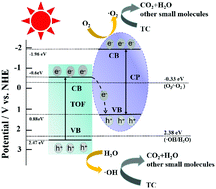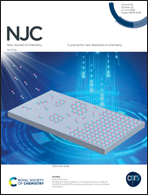In situ composite of Co-MOF on a Ti-based material for visible light multiphase catalysis: synthesis and the photocatalytic degradation mechanism
Abstract
The in situ synthesis method was used to grow Co-based one-dimensional MOF Co-PYDC (CP) on a pre-synthesized TiO2/TiOF2 (TOF) material which was used to treat tetracycline antibiotic wastewater. Through the degradation of tetracycline hydrochloride (TCH) under simulated sunlight, the photocatalytic activity of the synthesized samples was investigated. The results showed that the 5% CP/TOF photocatalyst exhibited the best photocatalytic performance on tetracycline hydrochloride degradation. The adsorption efficiency of TCH was 48% in the dark reaction for 0.5 h, and the removal efficiency reached 85% under 1.5 h simulated sunlight, which was much higher than those of TOF and CP monomers. Among them, the prepared 5% CP/TOF nanocomposite had a lower bandgap energy (2.63 eV), a larger specific surface area (52.01 m−2 g−1) and a lower electron–hole recombination rate. The synthesized CP/TOF photocatalyst showed promising application potential in antibiotic wastewater treatment. Moreover, the detected superoxide radical was the main active species, which further explained the degradation pathway and catalytic mechanism of the CP/TOF photocatalytic degradation of TCH, following the z-type heterojunction model. In this study, a CP/TOF composite material for photocatalytic degradation of tetracycline wastewater was designed and developed, which provided experimental methods and ideas for the practical treatment of wastewater.



 Please wait while we load your content...
Please wait while we load your content...